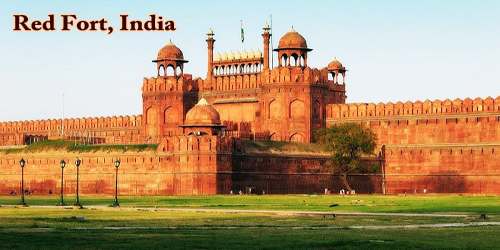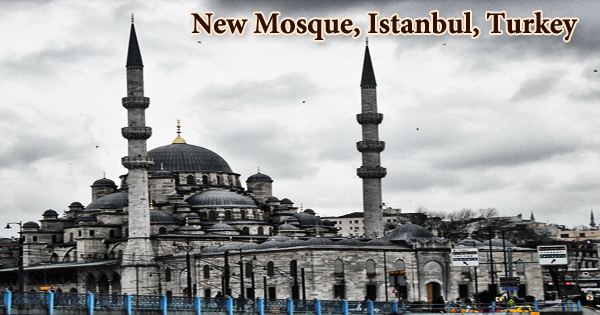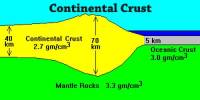The Red Fort, also called Lal Qalʿah, also spelled Lal Kila or Lal Qila, is a historic fort in the city of Delhi in India that served as the main residence of the Mughal Emperors. Emperor Shah Jahan commissioned the construction of the Red Fort on 12th May 1638, when he decided to shift his capital from Agra to Delhi. Originally red and white, Shah Jahan’s favorite colors, its design is credited to architect Ustad Ahmad Lahori, who also constructed the Taj Mahal. It was constructed between May 1639 and April 1648. The fort was designated a UNESCO World Heritage Site in 2007.
This imposing piece of architecture derives its name from its impregnable red sandstone walls. In addition to accommodating the emperors and their households, it was the ceremonial and political center of the Mughal state and the setting for events critically impacting the region. Today, this monument is home to several museums that have an assortment of precious artifacts on display. Every year, the Indian Prime Minister unfurls the national flag here on Independence Day.
Its English name red fort is a translation of the Hindustani Lāl Qila, deriving from its red-sandstone walls. As the residence of the imperial family, the fort was originally known as the “Blessed Fort” (Qila-i-Mubārak). Agra Fort is also known as Lāl Qila.
The fort’s massive red sandstone walls, which stand 75 feet (23 meters) high, enclose a complex of palaces and entertainment halls, projecting balconies, baths and indoor canals, and geometrical gardens, as well as an ornate mosque. Among the most famous structures of the complex are the Hall of Public Audience (Diwan-i-Am), which has 60 red sandstone pillars supporting a flat roof, and the Hall of Private Audience (Diwan-i-Khas), which is smaller, with a pavilion of white marble.
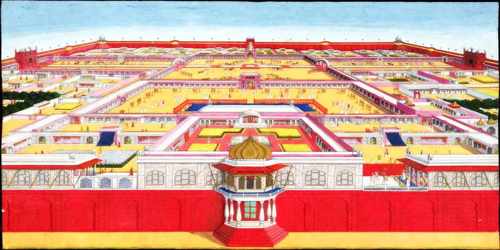
History –
The planning and design of the Red Fort represents a culmination of architectural development initiated in 1526 AD by the first Mughal Emperor and brought to a splendid refinement by Shah Jahan with a fusion of traditions: Islamic, Persian, Timurid, and Hindu. The innovative planning arrangements and architectural style of building components as well as the garden design developed in the Red Fort strongly influenced later buildings and gardens in Rajasthan, Delhi, Agra, and further afield. The Red Fort has been the setting for events that have had a critical impact on its geo-cultural region.
Constructed in 1639 by the fifth Mughal Emperor Shah Jahan as the palace of his fortified capital Shahjahanabad, the Red Fort is named for its massive enclosing walls of red sandstone. The imperial apartments consist of a row of pavilions, connected by a water channel known as the Stream of Paradise (Nahr-i-Bihisht). The Red Fort’s innovative architectural style, including its garden design, influenced later buildings and gardens in Delhi, Rajasthan, Punjab, Kashmir, Braj, Rohilkhand, and elsewhere.
The fort was plundered of its artwork and jewels during Nadir Shah’s invasion of the Mughal Empire in 1747. Most of the fort’s precious marble structures were subsequently destroyed by the British following the Revolt of 1857. The fort’s defensive walls were largely spared, and the fortress was subsequently used as a garrison. The Red Fort was also the site where the British put the last Mughal Emperor, Bahadur Shah II on trial before exiling him to Yangon (then Rangoon) in 1858.
The chief architect of the Red Fort was Ustad Ahmed Lahauri who started the construction in 1638 and completed in 1648. The fort lies along the Yamuna River, which fed the moats surrounding most of the walls. Construction began in the sacred month of Muharram, on 13th May 1638. Supervised by Shah Jahan, it was completed on 6th April 1648. Unlike other Mughal forts, the Red Fort’s boundary walls are asymmetrical to contain the older Salimgarh Fort. The fortress-palace was a focal point of the medieval city of Shahjahanabad, which is present-day Old Delhi. Shah Jahan’s successor, Aurangzeb, added the Pearl Mosque to the emperor’s private quarters, constructing barbicans in front of the two main gates to make the entrance to the palace more circuitous.
The red in the Red Fort was always not present. What many don’t know is that the edifice was painted red by the British only after the limestone from which the building was originally built in started to chip off. The name Red Fort finds its roots in the British era after they painted it in red to preserve it and thus rechristened it to Red Fort which then had its translation to Lal Qila among the land of the people.
With the passing away of Shah Jahan, the fate of the fort started to plummet as well. The successive rulers turned out to be defenseless against the rampages and pillages that followed. The Turk ruler Nadir Shah attacked the fort in 1739. The last Mughal ruler to have lived in the Red Fort was Bahadur Shah Zafar whose rule wasn’t so significant and the title was mere titular. Later when the British seized power and control, he was exiled to then Burma known as Myanmar now. And that was the end of the Mughal dynasty.
Most of the jewels and artwork of the Red Fort were looted and stolen during Nadir Shah’s invasion of 1747 and again after the failed Indian Rebellion of 1857 against the British. They were eventually sold to private collectors or the British Museum, British Library and the Victoria and Albert Museum. For example, the Koh-i-Noor diamond, the jade wine cup of Shah Jahan, and the crown of Bahadur Shah II are all currently located in London. Various requests for restitution have so far been rejected by the British government.
After Indian Independence, the site experienced few changes, and the Red Fort continued to be used as a military cantonment. A significant part of the fort remained under Indian Army control until 22nd December 2003, when it was given to the Archaeological Survey of India for restoration. It was designated a UNESCO World Heritage Site in 2007 as part of the Red Fort Complex. In 2009 the Comprehensive Conservation and Management Plan (CCMP), prepared by the Archaeological Survey of India under Supreme Court directions to revitalize the fort, was announced.
Architecture –
Formerly known as Quila-e-Mubarak or the Blessed Fort, the Red Fort lies along the banks of the river Yamuna, whose waters fed the moats surrounding the fort. It was a part of the medieval city of Shahjahanabad, popularly known today as ‘Old Delhi’. The entire fort complex is said to represent the architectural creativity and brilliance of Mughal architecture. With so much history and heritage associated with it, the Red Fort is one of the most popular monuments in India and a major tourist attraction in Delhi. It became a UNESCO world heritage site in 2007. The Archaeological Survey of India is at present responsible for the security and preservation of this magnificent monument. The Quṭb Mosque now stands on the site.
The Red Fort Complex is a layered expression of both Mughal architecture and planning and the later British military use of the forts. The most dramatic impacts on the integrity of the Red Fort Complex come from the change of the river into a major road, which alters the relationship of the property to its intended setting; and from the division of the Salimgarh Fort by a railway. Nevertheless, the Salimgarh Fort is inextricably linked to the Red Fort in use and later history. The integrity of the Salimgarh Fort can only be seen in terms of its value as part of the overall Red Fort Complex. The authenticity of the Mughal and British buildings in the Red Fort Complex is established, although more work is needed to establish the veracity of the current garden layout. In the specific case of the Salimgarh Fort, the authenticity of the Mughal period is related to knowledge of its use and associations, and of the built structures dating from the British period.
The Red Fort has an area of 254.67 acres (103.06 ha) enclosed by 2.41 kilometers (1.50 mi) of defensive walls, punctuated by turrets and bastions that vary in height from 18 meters (59 ft) on the riverside to 33 meters (108 ft) on the city side. The fort is octagonal, with the north-south axis longer than the east-west axis. The marble, floral decorations, and the fort’s double domes exemplify later Mughal architecture.
It showcases a high level of ornamentation, and the Kohinoor diamond was reportedly part of the furnishings. The fort’s artwork synthesizes Persian, European, and Indian art, resulting in a unique Shahjahani style rich in form, expression, and color. Red Fort is one of the building complexes of India encapsulating a long period of history and its arts. Even before its 1913 commemoration as a monument of national importance, efforts were made to preserve it for posterity.
The Lahori and Delhi Gates was used by the public, and the Khizrabad Gate was for the emperor. The Lahori Gate is the main entrance, leading to a domed shopping area known as the Chatta Chowk (covered bazaar).
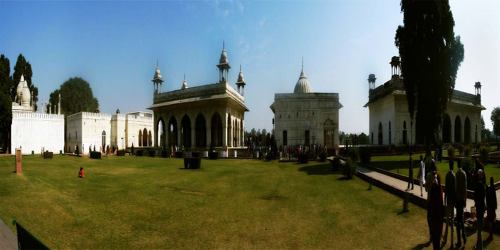
On entering the Diwan-i-‘Am, visitors will see the Naubat-Khana (Drum House). It is where the musicians played during ceremonial events. The huge hall has nine arches. The royal throne would be placed in the hall on the decorated alcove. Diwan-i-Khas is where the legendary peacock throne was said to be before it was looted by Nadir Shah. The Red Fort also has Mumtaz Mahal which is now a museum, Rang Mahal, Khwabgah or the sleeping chambers, the Hammam or the royal bathing area with a garden without which any Mughal architecture is incomplete.
Red Fort can be visited on every day except Mondays. The Red Fort timings are from 9.30 am to 4.30 pm. The best time to visit is from October to February as this is when Delhi can be toured in its best form. Visitors can come here post 6 in the evening for the light and sound show available in two languages: English and Hindi. The visiting hours for Red Fort for the light and sound show vary according to months and the language chosen.
Information Sources:
